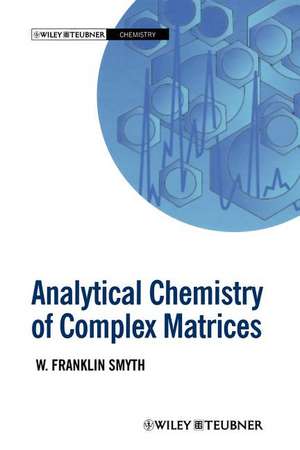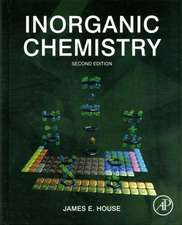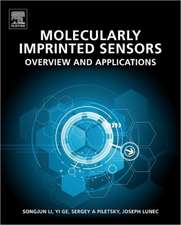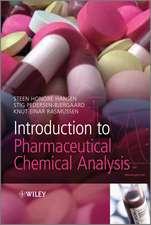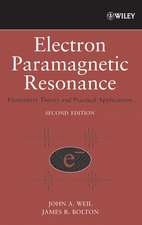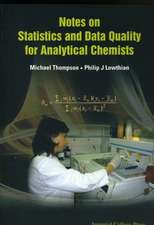Analytical Chemistry of Complex Matrices
Cu W. Franklin Smythde Limba Germană Paperback – 5 apr 2012
Preț: 212.66 lei
Nou
Puncte Express: 319
Preț estimativ în valută:
40.69€ • 42.60$ • 33.67£
40.69€ • 42.60$ • 33.67£
Carte tipărită la comandă
Livrare economică 07-21 aprilie
Preluare comenzi: 021 569.72.76
Specificații
ISBN-13: 9783322871831
ISBN-10: 3322871835
Pagini: 232
Ilustrații: XIII, 213 S.
Dimensiuni: 152 x 229 x 12 mm
Greutate: 0.32 kg
Ediția:Softcover reprint of the original 1st ed. 1996
Editura: Vieweg+Teubner Verlag
Colecția Vieweg+Teubner Verlag
Locul publicării:Wiesbaden, Germany
ISBN-10: 3322871835
Pagini: 232
Ilustrații: XIII, 213 S.
Dimensiuni: 152 x 229 x 12 mm
Greutate: 0.32 kg
Ediția:Softcover reprint of the original 1st ed. 1996
Editura: Vieweg+Teubner Verlag
Colecția Vieweg+Teubner Verlag
Locul publicării:Wiesbaden, Germany
Public țintă
Upper undergraduateCuprins
1: Historical Background.- 2: Unit Processes of Analytical Procedures.- 2.1 Unit Process No. 1. Definition of the Problem.- 2.2 Unit Process No. 2. Choice of Method.- 2.3 Unit Process No. 3. Obtaining a Representative Sample and its Measurement.- 2.3.1 Solid Materials.- 2.3.2 Liquid Materials.- 2.3.3 Gaseous Materials.- 2.4 Unit Process No. 4. Preliminary Treatment of Sample.- 2.5 Unit Process No. 5. Separation of Analyte(s) from Interferences and Each Other.- 2.5.1 Separation by Masking.- 2.5.2 Separation by Precipitation.- 2.5.3 Separation by Solvent Extraction.- 2.5.4 Separation by Solid-Phase Extraction.- 2.5.5 Separation by Chromatography.- 2.5.6 Separation by Electrophoresis.- 2.6 Unit Process No. 6. Measurement.- 2.7 Unit Process No. 7. Statistical Assessment of Measurements.- 2.8 Unit Process No. 8. Calculation of Analytical Result and Solution to Problem.- 2.8.1 Quantitative Analysis.- 2.8.1.1 Calibration Curves.- 2.8.1.2 Standard Addition Method.- 2.8.1.3 Internal Standard Method.- 2.8.1.4 Internal Normalization Method.- 2.8.2 Qualitative Analysis.- 2.9 Rule of Computers and Microprocessors in Modern Analytical Methods.- 2.9.1 Instrument Operation.- 2.9.2 Data Recording and Storage.- 2.9.3 Data Processing and Analysis.- 2.9.4 Validation Testing.- 2.9.5 Software for Method Development.- 2.10 Automation of Unit Processes.- 2.10.1 Automation of Repetitive Analysis.- 2.10.2 Continuous On-Line Monitoring.- 2.10.3 Laboratory Robotics.- 2.10.4 Application of Robotics to Dissolution Tests.- 2.10.5 Application of Robotics to Drug Determination in Biological Fluids.- 3: Selected Analytical Problems Involving Inorganic Analytes Which Contain Elements From Groups IA–VIIIA and the Lanthanides.- 3.1 Determination of Sodium and Potassium in Mineral Water by Flame EmissionSpectrometry.- 3.1.1 Summary.- 3.1.2 Introduction.- 3.1.3 Procedure.- 3.2 Determination of Water Hardness, i.e. Total Calcium and Magnesium, by EDTA Titration.- 3.2.1 Summary.- 3.2.2 Introduction.- 3.2.3 Procedure.- 3.2.4 Calculation.- 3.3 Gravimetric Determination of Cerium in Ore.- 3.3.1 Summary.- 3.3.2 Introduction.- 3.3.3 Procedure.- 3.4 Spectrophotometric Determination of Titanium in Rock.- 3.4.1 Summary.- 3.4.2 Introduction.- 3.4.3 Procedure.- 3.4.4 Calculation.- 3.5 Determination of Vanadium(V) in Sea Water by Adsorptive Stripping Voltammetry.- 3.5.1 Summary.- 3.5.2 Introduction.- 3.5.3 Procedure.- 3.6 Determination of Trace Concentrations of Molybdenum in Water Samples by Solvent Extraction of a Neutrally Charged Chelate Followed by Atomic Absorption Spectrometry.- 3.6.1 Summary.- 3.6.2 Introduction.- 3.6.3 Procedure.- 3.7 Differential Thermal Analysis (DTA) of a Complex Manganese Compound Mn(PH2O2)H2O.- 3.7.1 Summary.- 3.7.2 Introduction.- 3.7.3 Procedure.- 3.8 Determination of Iron in an Ore by Redox Titration with Potassium Permanganate.- 3.8.1 Summary.- 3.8.2 Introduction.- 3.8.3 Procedure.- 3.8.4 Calculation.- 3.9 Determination of Cobalt in Soil Samples by Visible Spectrophotometry.- 3.9.1 Summary.- 3.9.2 Introduction.- 3.9.3 Procedure and Calculation.- 3.10 Gravimetric Determination of Nickel in Steel.- 3.10.1 Summary.- 3.10.2 Introduction.- 3.10.3 Procedure.- 4: Selected Analytical Problems Involving Inorganic and Organometallic Analytes Which Contain Elements From Groups IB–VIIB.- 4.1 Determination of Trace Concentrations of Copper in the Aqueous Environment by Stripping Voltammetry.- 4.1.1 Summary.- 4.1.2 Introduction.- 4.1.3 Procedure.- 4.1.4 Calculation.- 4.2 Determination of Organomercury Compounds in Fish Samples by HPLC—Cold Vapour AtomicAbsorption Spectrometry.- 4.2.1 Summary.- 4.2.2 Introduction.- 4.2.3 Procedure.- 4.3 Determination of Zinc in a Pharmaceutical Formulation by Ion-Exchange Separation and Complexometric Titration.- 4.3.1 Summary.- 4.3.2 Introduction.- 4.3.3 Procedure.- 4.4 Visible Spectrophotometric Determination of Boron in Plants.- 4.4.1 Summary.- 4.4.2 Introduction.- 4.4.3 Procedure.- 4.4.4 Calculation.- 4.5 Determination of Organolead Compounds in Air Samples by Gas Chromatography—Atomic Absorption Spectrometry.- 4.5.1 Summary.- 4.5.2 Introduction.- 4.5.3 Procedure.- 4.6 Determination of Nitrogen Dioxide in Air Samples by Sorbent Tube Collection—Colorimetry.- 4.6.1 Summary.- 4.6.2 Introduction.- 4.6.3 Procedure.- 4.6.4 Calculation.- 4.7 Determination of Arsenic in Hair Samples by Neutron Activation Analysis and in Wallpaper by X-ray Fluorescence Spectrometry.- 4.7.1 Summary.- 4.7.2 Introduction.- 4.7.3 Procedure.- 4.8 Determination of Antimony in Liver Samples using Hydride Generation—Atomic Absorption Spectrometry.- 4.8.1 Summary.- 4.8.2 Introduction.- 4.8.3 Procedure.- 4.9 Determination of Selenium in Natural Waters by Spectrofluorimetry.- 4.9.1 Summary.- 4.9.2 Introduction.- 4.9.3 Procedure and Calculation.- 4.10 Determination of Fluoride in Potable Water by Ion-Selective Electrode Measurements.- 4.10.1 Summary.- 4.10.2 Introduction.- 4.10.3 Procedure.- 4.10.4 Calculation.- 4.11 Multielement Analysis of a Biological Fluid by Inductively Coupled Plasma Mass Spectrometry (ICP-MS).- 4.11.1 Summary.- 4.11.2 Introduction.- 4.11.3 Procedure.- 5: Selected Analytical Problems Involving Organic Analytes Which are the Major or Minor Constituents of a Sample.- 5.1 Comparison of Analytical Methods Based on Visible Spectrophotometry, Solvent Extraction—UV Spectrophotometry,Voltammetry, NMR and HPLC for the Determination of the Active Constituents of Analgesic Formulations.- 5.1.1 Summary.- 5.1.2 Visible Spectrophotometric Method.- 5.1.2.1 Introduction.- 5.1.2.2 Procedure.- 5.1.2.3 Calculation.- 5.1.3 Solvent Extraction—UV Spectrophotometric Method.- 5.1.3.1 Introduction and Procedure.- 5.1.4 Voltammetric Method.- 5.1.4.1 Introduction.- 5.1.4.2 Procedure.- 5.1.5 NMR Method.- 5.1.5.1 Introduction.- 5.1.5.2 Calculation.- 5.1.6 HPLC Method.- 5.1.6.1 Introduction.- 5.1.6.2 Procedure.- 5.2 Stability-Indicating High-Performance Liquid Chromatographic Assay for Oxazepam Tablets and Capsules.- 5.2.1 Summary.- 5.2.2 Introduction.- 5.2.3 Procedure.- 5.3 Separation of Water-Soluble Vitamins by Capillary Zone Electrophoresis and Micellar Electrophoretic Capillary Chromatography (MECC).- 5.3.1 Summary.- 5.3.2 Introduction.- 5.3.3 Procedure.- 5.4 Air-Segmented Continuous-Flow Visible Spectrophotometric Determination of Cephalosporins in Drug Formulations by Alkaline Degradation to Hydrogen Sulphide and Formation of Methylene Blue.- 5.4.1 Summary.- 5.4.2 Introduction.- 5.4.3 Procedure.- 5.5 Use of IR Spectrometry to Identify an Active Raw Material, Procaine Penicillin G, Used in the Pharmaceutical Industry.- 5.5.1 Summary.- 5.5.2 Introduction.- 5.5.3 Procedure.- 5.6 Qualitative and Quantitative Analysis of a Polymeric Material using Thermogravimetric Analysis (TGA).- 5.6.1 Summary.- 5.6.2 Introduction.- 5.6.3 Procedure.- 6: Organic Trace Analysis of Low Molecular Weight Analytes in Environmental Samples and Biological Materials.- 6.1 Determination of Aromatic and Aliphatic Isocyanates in Workplace Atmospheres by HPLC.- 6.1.1 Summary.- 6.1.2 Introduction.- 6.1.3 Procedure.- 6.1.4 Calculation.- 6.2 Determination of Triazine Pesticide Residues inEnvironmental Samples by Enzyme-Linked Immunosorbent Assay (ELISA).- 6.2.1 Summary.- 6.2.2 Introduction.- 6.2.3 Procedure.- 6.3 Analysis of Alcoholic Beverages.- 6.3.1 Summary.- 6.3.2 Introduction.- 6.3.3 Procedure.- 6.4 Determination of Contaminating Antibiotic Trace Concentrations in Dairy Feedstuffs by GC—MS.- 6.4.1 Summary.- 6.4.2 Introduction.- 6.4.3 Procedure.- 6.5 Extraction of Cocaine and its Metabolites from a Urine Sample by Solid-Phase Extraction.- 6.5.1 Summary.- 6.5.2 Introduction.- 6.5.3 Procedure.- 6.6 Determination of Nitroglycerin, 2,4-Dinitrotoluene and Diphenylamine in Gunshot Residue by High-Performance Liquid Chromatography with Electrochemical Detection (HPLC—ED).- 6.6.1 Summary.- 6.6.2 Introduction.- 6.6.3 Procedure.- 6.7 Determination of Prozac (Fluoxetine) and its Demethylated Metabolite in Serum by HPLC with Fluorescence Detection.- 6.7.1 Summary.- 6.7.2 Introduction.- 6.7.3 Procedure.- 6.8 Direct Determination of Thioamide Drugs in Biological Fluids by Cathodic Stripping Voltammetry.- 6.8.1 Summary.- 6.8.2 Introduction.- 6.8.3 Procedure.- 6.8.4 Calculation.- 7: Analysis of High Molecular Weight Analytes.- 7.1 Analysis of Abnormal or Variant Haemoglobins by HPLC-Electrospray MS.- 7.1.1 Summary.- 7.1.2 Introduction.- 7.1.3 Procedure.- 7.2 Determination of Insulin by Radioimmunoassay (RIA).- 7.2.1 Summary.- 7.2.2 Introduction.- 7.2.3 Procedure.- 7.2.4 Calculation.- 7.3 Fluorescence of Europium Chelates and its Application to Fluoroimmunoassay of Prostate-Specific Antigen (PSA) in Human Serum.- 7.3.1 Summary.- 7.3.2 Introduction.- 7.3.3 Procedure.- References.
Textul de pe ultima copertă
There is currently much interest in analytical problems dealing with the identification and determination of organic inorganic and organometallic analytes in complex matrices of topical importance such as athmosphere,factory air,water,plants,soils,foods and industrial products.The key element of the analytical process range from problem definition through sampling, separation and calculations to the sampling, separation and calculations to the solution. This comprehensive text starts by introducing the reader to the unit processes involved in analytical procedures, including the role of computers in modern analytical methods and the automation of unit processes. It goes on to discuss a wide range of selected analytical problem involving inorganic, organometallic and organic analytes in a wide range of matrices. Examples of trace analysis of low molecular weight analytes in environmental samples and biological materials are also presented. Contents: Introduction, Historical Background, Unit Processes of Analytical Procedures, Selected Analytical Problems Involving Inorganic Analytes which Contain Elements of Group IA-VIIIA and the Lanthanides, Selected Analytical Problems Involving Organic and Organometallic Anlytes which Contains Group IB-VIIB, Selected Analytical Problems Involving Organic Analytes which are the Major or Minor Constituents of a Sample, Organic Trace Analysis of Low Molecular Weight Analytes in Environmental Samples and Biological Materials, Analysis of High Molecular Weight Analytes, References, Index.
